Combined Effects of Land Use/Cover Change and Climate Change on Runoff in the Jinghe River Basin, China
Abstract
:1. Introduction
2. Materials and Methods
2.1. Study Area
2.2. Data Sources
2.3. Methods
2.3.1. Cellular Automata–Markov Model
2.3.2. SWAT Model
2.3.3. Scenario Settings
3. Results
3.1. Meteorological Variation Characteristics
3.1.1. Historical Climate Change Characteristics
3.1.2. Future Climate Change Characteristics
3.2. Characterization and Prediction of LUCC
3.2.1. Historical LUCC Characteristics
3.2.2. CA–Markov Model Applicability Analysis
3.2.3. Future LUCC Scenarios
3.3. Quantitative Evaluation of the Impact of Climate Change and LUCC on Runoff Change
3.3.1. Applicability Analysis of the SWAT Model
3.3.2. Runoff Response to Future Climate Change
3.3.3. Runoff Responses to Future Climate Change and LUCC
3.3.4. Combined Effects of Climate Change and LUCC on Runoff Change
4. Discussion
4.1. Uncertainty Analysis
4.2. Strategies for Rational Utilization of Water Resources in the Future
4.3. Limitations of the Study
5. Conclusions
Author Contributions
Funding
Data Availability Statement
Acknowledgments
Conflicts of Interest
Abbreviations
References
- Pan, Z.; Liu, P.; Gao, S.; Xia, J.; Chen, J.; Cheng, L. Improving hydrological projection performance under contrasting climatic conditions using spatial coherence through a hierarchical Bayesian regression framework. Hydrol. Earth Syst. Sci. 2019, 23, 3405–3421. [Google Scholar] [CrossRef] [Green Version]
- Yang, W.; Jin, F.; Si, Y.; Li, Z. Runoff change controlled by combined effects of multiple environmental factors in a headwater catchment with cold and arid climate in northwest China. Sci. Total Environ. 2021, 756, 143995. [Google Scholar] [CrossRef]
- North, M.A.; Hunter, N.B.; Roberts, D.C.; Slotow, R. Science for implementation: The roles, experiences, and perceptions of practitioners involved in the Intergovernmental Panel on Climate Change. Clim. Action 2022, 1, 25. [Google Scholar] [CrossRef]
- Papalexiou, S.M.; Montanari, A. Global and regional increase of precipitation extremes under global warming. Water Resour. Res. 2019, 55, 4901–4914. [Google Scholar] [CrossRef]
- Prein, A.F.; Rasmussen, R.M.; Ikeda, K.; Liu, C.; Clark, M.P.; Holland, G.J. The future intensification of hourly precipitation extremes. Nat. Clim. Chang. 2017, 7, 48–52. [Google Scholar] [CrossRef]
- Ahn, K.H.; Merwade, V. Quantifying the relative impact of climate and human activities on streamflow. J. Hydrol. 2014, 515, 257–266. [Google Scholar] [CrossRef]
- Alamdari, N.; Claggett, P.; Sample, D.J.; Easton, Z.M.; Nayeb, Y.M. Evaluating the joint effects of climate and land use change on runoff and pollutant loading in a rapidly developing watershed. J. Clean. Prod. 2022, 330, 129953. [Google Scholar] [CrossRef]
- Feng, Q.; Liu, W.; Xi, H.; Yang, W.; Jin, F.; Si, Y.; Li, Z. Comprehensive evaluation and indicator system of land desertification in the Heihe River Basin. Nat. Hazards 2013, 65, 1573–1588. [Google Scholar] [CrossRef]
- Liu, Y.; Tian, J.; Liu, R.; Ding, L. Influences of climate change and human activities on NDVI changes in China. Remote Sens. 2021, 13, 4326. [Google Scholar] [CrossRef]
- Wang, Q.; Xu, Y.; Cai, X.; Tang, J.; Yang, L. Role of underlying surface, rainstorm and antecedent wetness condition on flood responses in small and medium sized watersheds in the Yangtze River Delta region, China. Catena 2021, 206, 105489. [Google Scholar] [CrossRef]
- Chen, Q.; Chen, H.; Zhang, J.; Hou, Y.; Shen, M.; Chen, J.; Xu, C. Impacts of climate change and LULC change on runoff in the Jinsha River Basin. J. Geogr. Sci. 2020, 30, 85–102. [Google Scholar] [CrossRef] [Green Version]
- Yin, J.; Gentine, P.; Zhou, S.; Sullivan, S.C.; Wang, R.; Zhang, Y.; Guo, S. Large increase in global storm runoff extremes driven by climate and anthropogenic changes. Nat. Commun. 2018, 9, 4389. [Google Scholar] [CrossRef] [Green Version]
- Abdelkarim, A.; Alogayell, H.M.; Alkadi, I.I.; Youssef, I. Spatial–temporal prediction model for land cover of the rural–urban continuum axis between Ar-Riyadh and Al-Kharj cities in KSA in the year of 2030 using the integration of CA–Markov model, GIS-MCA, and AHP. Appl. Geomat. 2022, 14, 501–525. [Google Scholar] [CrossRef]
- Dunn, S.M.; Brown, I.; Sample, J.; Post, H. Relationships between climate, water resources, land use and diffuse pollution and the significance of uncertainty in climate change. J. Hydrol. 2012, 434, 19–35. [Google Scholar] [CrossRef]
- Huo, J.; Shi, Z.; Zhu, W.; Xue, H.; Chen, X. A multi-scenario simulation and optimization of land use with a Markov–FLUS coupling model: A case study in Xiong’an New Area, China. Sustainability 2022, 14, 2425. [Google Scholar] [CrossRef]
- Liu, G.; Jin, Q.; Li, J.; Li, L.; He, C.; Huang, Y.; Yao, Y. Policy factors impact analysis based on remote sensing data and the CLUE-S model in the Lijiang River Basin, China. Catena 2017, 158, 286–297. [Google Scholar] [CrossRef]
- Siddique, M.A.; Wang, Y.; Xu, N.; Ullah, N.; Zeng, P. The spatiotemporal implications of urbanization for urban heat islands in Beijing: A predictive approach based on CA–Markov modeling (2004–2050). Remote Sens. 2021, 13, 4697. [Google Scholar] [CrossRef]
- Chen, X.; Han, R.; Feng, P.; Wang, Y. Combined effects of predicted climate and land use changes on future hydrological droughts in the Luanhe River basin, China. Nat. Hazards 2021, 110, 1305–1337. [Google Scholar] [CrossRef]
- Daba, M.H.; You, S. Quantitatively assessing the future land-use/land-cover changes and their driving factors in the Upper Stream of the Awash River Based on the CA–Markov model and their implications for water resources management. Sustainability 2022, 14, 1538. [Google Scholar] [CrossRef]
- Li, T.; Liu, D.; Han, S.; Ming, G.; Fan, J.; Meng, X.; Huang, Q. Closing the feedback of evapotranspiration on the atmospheric evaporation demand based on a complementary relationship. Atmosphere 2022, 13, 1431. [Google Scholar] [CrossRef]
- Piras, M.; Mascaro, G.; Deidda, R.; Vivoni, E.R. Quantification of hydrologic impacts of climate change in a Mediterranean basin in Sardinia, Italy, through high-resolution simulations. Hydrol. Earth Syst. Sci. 2014, 18, 5201–5217. [Google Scholar] [CrossRef] [Green Version]
- Zhang, L.; Jiang, Y.; Yang, M.; Wang, H.; Dong, N.; Wang, H.; Liu, X.; Chen, L.; Liu, K. Quantifying the impacts of land use and cover change (LUCC) and climate change on discharge and sediment load in the Hunhe River Basin, Liaoning Province, Northeast China. Water 2022, 14, 737. [Google Scholar] [CrossRef]
- Yan, B.; Xu, Y. Quantifying interaction uncertainty between subwatersheds and base-flow partitions on hydrological processes. PLoS ONE 2022, 17, e0261859. [Google Scholar] [CrossRef] [PubMed]
- Zang, W.; Liu, S.; Huang, S.; Li, J.; Fu, Y.; Sun, Y.; Zheng, J. Impact of urbanization on hydrological processes under different precipitation scenarios. Nat. Hazards 2019, 99, 1233–1257. [Google Scholar] [CrossRef]
- Cai, L.; Chen, X.; Huang, R.; Smettem, K. Runoff change induced by vegetation recovery and climate change over carbonate and non-carbonate areas in the karst region of South-west China. J. Hydrol. 2022, 604, 127231. [Google Scholar] [CrossRef]
- Farsi, N.; Mahjouri, N. Evaluating the contribution of the climate change and human activities to runoff change under uncertainty. J. Hydrol. 2019, 574, 872–891. [Google Scholar] [CrossRef]
- Lian, J.; Chen, H.; Wang, F.; Nie, Y.; Wang, K. Separating the relative contributions of climate change and ecological restoration to runoff change in a mesoscale karst basin. Catena 2020, 194, 104705. [Google Scholar] [CrossRef]
- Xue, D.; Zhou, J.; Zhao, X.; Liu, C.; Wei, W.; Yang, X.; Li, Q.; Zhao, Y. Impacts of climate change and human activities on runoff change in a typical arid watershed, NW China. Ecol. Indic. 2021, 121, 107013. [Google Scholar] [CrossRef]
- Chen, S.; Fu, Y.H.; Wu, Z.; Hao, F.; Hao, Z.; Guo, Y.; Geng, X.; Li, X.; Zhang, X.; Tang, J.; et al. Informing the SWAT model with remote sensing detected vegetation phenology for improved modeling of ecohydrological processes. J. Hydrol. 2023, 616, 128817. [Google Scholar] [CrossRef]
- Han, D.; Wang, G.; Liu, T.; Xue, B.; Kuczera, G.; Xu, X. Hydroclimatic response of evapotranspiration partitioning to prolonged droughts in semiarid grassland. J. Hydrol. 2018, 563, 766–777. [Google Scholar] [CrossRef]
- Chi, Q.; Zhou, S.; Wang, L.; Zhu, M.; Liu, D.; Tang, W.; Zhao, X.; Xu, S.; Ye, S.; Lee, J.; et al. Quantifying the contribution of LUCC to surface energy budget: A case study of four typical cities in the Yellow River Basin in China. Atmosphere 2021, 12, 1374. [Google Scholar] [CrossRef]
- Shen, M.; Chen, J.; Zhuan, M.; Chen, H.; Xu, C.Y.; Xiong, L. Estimating uncertainty and its temporal variation related to global climate models in quantifying climate change impacts on hydrology. J. Hydrol. 2018, 556, 10–24. [Google Scholar] [CrossRef]
- Zhao, L.; Wang, W.; Li, M.; Xu, G. A comparative study on the coevolution and drivers of environmental risks and man–land relationship between China and the United States from the perspective of LUCC. Atmosphere 2023, 14, 288. [Google Scholar] [CrossRef]
- Xu, C.; Jiang, Y.; Su, Z.; Liu, Y.; Lyu, J. Assessing the impacts of Grain-for-Green Programme on ecosystem services in Jinghe River basin, China. Ecol. Indic. 2022, 137, 108757. [Google Scholar] [CrossRef]
- Lyu, J.; Yin, S.; Sun, Y.; Wang, K.; Luo, P.; Meng, X. Flood runoff simulation under changing environment, based on multiple satellite data in the Jinghe River Basin of the Loess Plateau, China. Remote Sens. 2023, 15, 550. [Google Scholar] [CrossRef]
- Wang, H.; Liu, G.; Li, Z.; Wang, P.; Wang, Z. Assessing the driving forces in vegetation dynamics using net primary productivity as the indicator: A case study in Jinghe River Basin in the Loess Plateau. Forests 2018, 9, 374. [Google Scholar] [CrossRef] [Green Version]
- Tang, C.; Li, J.; Zhou, Z.; Zeng, L.; Zhang, C.; Ran, H. How to optimize ecosystem services based on a Bayesian model: A case study of Jinghe River Basin. Sustainability 2019, 11, 4149. [Google Scholar] [CrossRef] [Green Version]
- Varmaghani, A.; Eichinger, W.E.; Prueger, J.H. Modification of FAO Penman–Monteith equation for minor components of energy. Hydrol. Res. 2019, 50, 607–615. [Google Scholar] [CrossRef]
- Liu, Y.; Jia, Z.; Ma, X.; Wang, Y.; Guan, R.; Guan, Z.; Gu, Y.; Zhao, W. Analysis of drought characteristics projections for the Tibetan Plateau based on the GFDL-ESM2M climate model. Remote Sens. 2022, 14, 5084. [Google Scholar] [CrossRef]
- Faichia, C.; Tong, Z.; Zhang, J.; Liu, X.; Kazuva, E.; Ullah, K.; AlShaibah, B. Using RS data-based CA–Markov model for dynamic simulation of historical and future LUCC in Vientiane, Laos. Sustainability 2020, 12, 8410. [Google Scholar] [CrossRef]
- Novin, M.S.; Ebrahimipour, A. Spatio-temporal modelling of land use changes by means of CA–Markov model. Model. Earth Syst. Environ. 2019, 5, 1253–1263. [Google Scholar] [CrossRef]
- Wang, Q.; Xu, Y.; Wang, Y.; Zhang, Y.; Xiang, J.; Xu, Y.; Wang, J. Individual and combined impacts of future land-use and climate conditions on extreme hydrological events in a representative basin of the Yangtze River Delta, China. Atmos. Res. 2020, 236, 104805. [Google Scholar] [CrossRef]
- Wu, X.; Lin, A.Q.; Li, Y.; Wu, H.; Cen, L.Y.; Liu, H.; Song, D.X. Simulating spatiotemporal land use change in middle and high latitude regions using multiscale fusion and cellular automata: The case of Northeast China. Ecol. Indic. 2021, 133, 108449. [Google Scholar] [CrossRef]
- Zhang, J.; Wang, Y. Runoff prediction under different precipitation scenarios based on SWAT model and stochastic simulation of precipitation. J. Hydrol. Eng. 2022, 27, 05022003. [Google Scholar] [CrossRef]
- Alejo, L.A.; Ella, V.B.; Saludes, R.B. Applicability of the climate hazards group infrared precipitation with stations as rainfall input for SWAT watershed modeling. Water Resour. 2021, 48, 925–935. [Google Scholar] [CrossRef]
- Li, M.; Di, Z.; Duan, Q. Effect of sensitivity analysis on parameter optimization: Case study based on streamflow simulations using the SWAT model in China. J. Hydrol. 2021, 603, 126896. [Google Scholar] [CrossRef]
- Lv, L.; Han, L.; Wen, X.; Shao, H.; Liu, S. Spatiotemporal changes in water yield function and its influencing factors in the Tibetan Plateau in the past 20 years. Atmosphere 2023, 14, 925. [Google Scholar] [CrossRef]
- Zhang, L.; Dawes, W.R.; Walker, G.R. Response of mean annual evapotranspiration to vegetation changes at catchment scale. Water Resour. Res. 2001, 37, 701–708. [Google Scholar] [CrossRef]
- Yang, H.; Luo, P.; Wang, J.; Mou, C.; Mo, L.; Wang, Z.; Fu, Y.; Lin, H.; Yang, Y.; Bhatta, L.D. Ecosystem evapotranspiration as a response to climate and vegetation coverage changes in Northwest Yunnan, China. PLoS ONE 2017, 10, e0134795. [Google Scholar] [CrossRef]
- Ni, Y.; Yu, Z.; Lv, X.; Ma, L.; Zhang, Q.; Wang, J. Response of runoff to vegetation change in typical basin of the Loess Plateau. Ecol. Eng. 2022, 182, 106704. [Google Scholar] [CrossRef]
- Makumbura, R.K.; Gunathilake, M.B.; Samarasinghe, J.T.; Confesor, R.; Muttil, N.; Rathnayake, U. Comparison of calibration approaches of the soil and water assessment tool (SWAT) model in a Tropical Watershed. Hydrology 2022, 9, 183. [Google Scholar] [CrossRef]
- Ji, G.; Lai, Z.; Xia, H.; Liu, H.; Wang, Z. Future runoff variation and flood disaster prediction of the Yellow River Basin based on CA-Markov and SWAT. Land 2021, 10, 421. [Google Scholar] [CrossRef]
- Chen, C.; Gan, R.; Feng, D.; Yang, F.; Zuo, Q. Quantifying the contribution of SWAT modeling and CMIP6 inputting to streamflow prediction uncertainty under climate change. J. Clean. Prod. 2022, 364, 132675. [Google Scholar] [CrossRef]
- Chen, J.; Du, C.; Nie, T.; Han, X.; Tang, S. Study of non-point pollution in the Ashe River Basin based on SWAT model with different land use. Water 2022, 14, 2177. [Google Scholar] [CrossRef]
- Schneider, U.; Finger, P.; Meyer-Christoffer, A.; Rustemeier, E.; Ziese, M.; Becker, A. Evaluating the hydrological cycle over land using the newly-corrected precipitation climatology from the global precipitation climatology centre (GPCC). Atmosphere 2017, 8, 52. [Google Scholar] [CrossRef] [Green Version]
- Zhang, H.; Huang, G.H.; Wang, D.; Zhang, X. Uncertainty assessment of climate change impacts on the hydrology of small prairie wetlands. J. Hydrol. 2010, 396, 94–103. [Google Scholar] [CrossRef] [Green Version]
- Chevuturi, A.; Klingaman, N.P.; Turner, A.G.; Guo, L.; Vidale, P.L. Projected changes in the East Asian hydrological cycle for different levels of future global warming. Atmosphere 2022, 13, 405. [Google Scholar] [CrossRef]
- Trolle, D.; Nielsen, A.; Andersen, H.E.; Thodsen, H.; Olesen, J.E.; Børgesen, C.D.; Refsgaard, J.C.; Sonnenborg, T.O.; Karlsson, I.B.; Christensen, J.P.; et al. Effects of changes in land use and climate on aquatic ecosystems: Coupling of models and decomposition of uncertainties. Sci. Total Environ. 2018, 657, 627–633. [Google Scholar] [CrossRef]
- Joseph, J.; Ghosh, S.; Pathak, A.; Sahai, A.K. Hydrologic impacts of climate change: Comparisons between hydrological parameter uncertainty and climate model uncertainty. J. Hydrol. 2018, 566, 1–22. [Google Scholar] [CrossRef]
- Koulelis, P.P.; Proutsos, N.; Solomou, A.D.; Avramidou, E.V.; Malliarou, E.; Athanasiou, M.; Xanthopoulos, G.; Petrakis, P.V. Effects of climate change on greek forests: A review. Atmosphere 2023, 14, 1155. [Google Scholar] [CrossRef]
- Fan, Q.; Ding, S. Landscape pattern changes at a county scale: A case study in Fengqiu, Henan Province, China from 1990 to 2013. Catena 2016, 137, 152–160. [Google Scholar] [CrossRef]
- Gedefaw, M.; Denghua, Y.; Girma, A. Assessing the impacts of land use/land cover changes on water resources of the Nile River Basin, Ethiopia. Atmosphere 2023, 14, 749. [Google Scholar] [CrossRef]
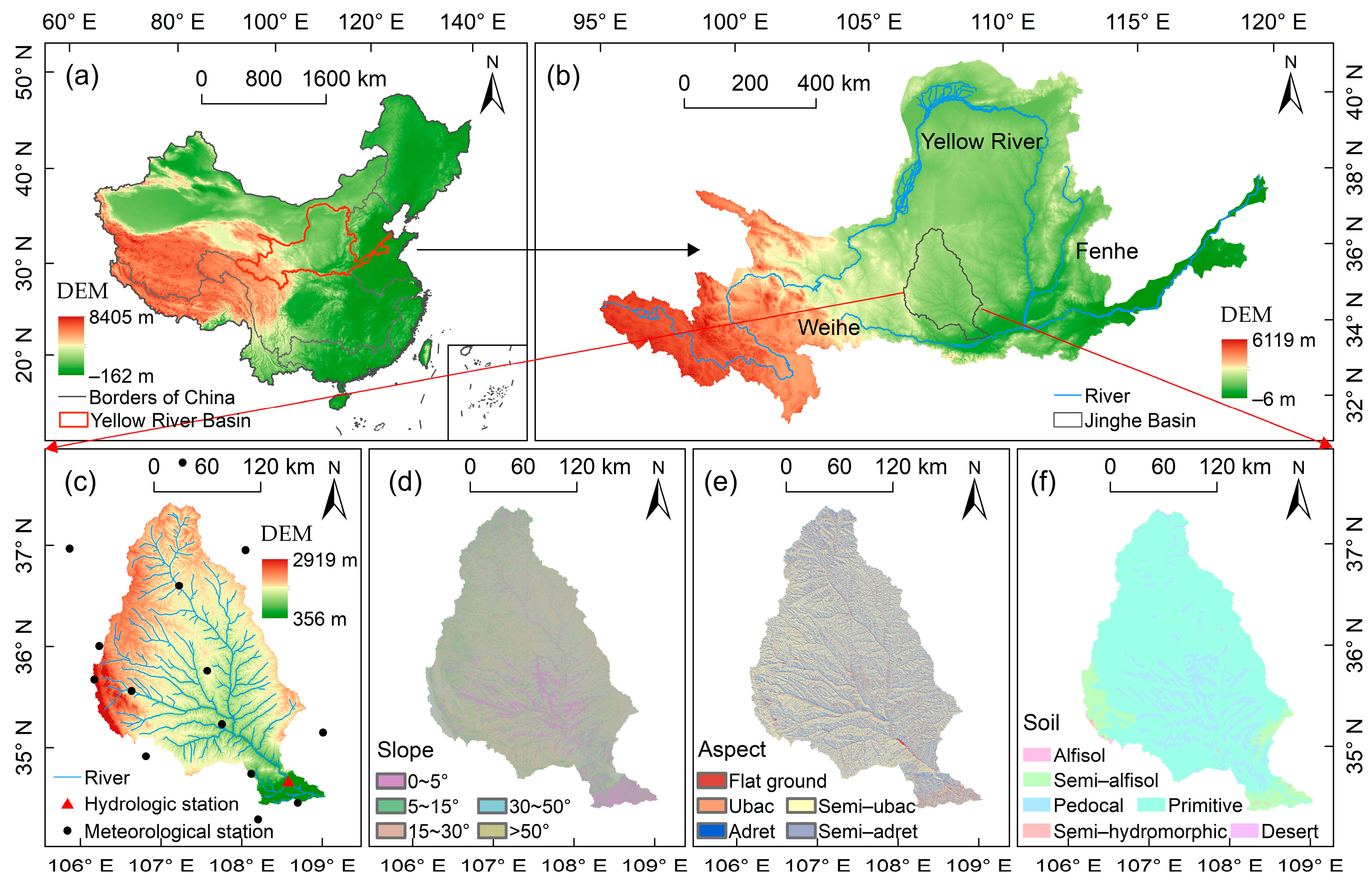

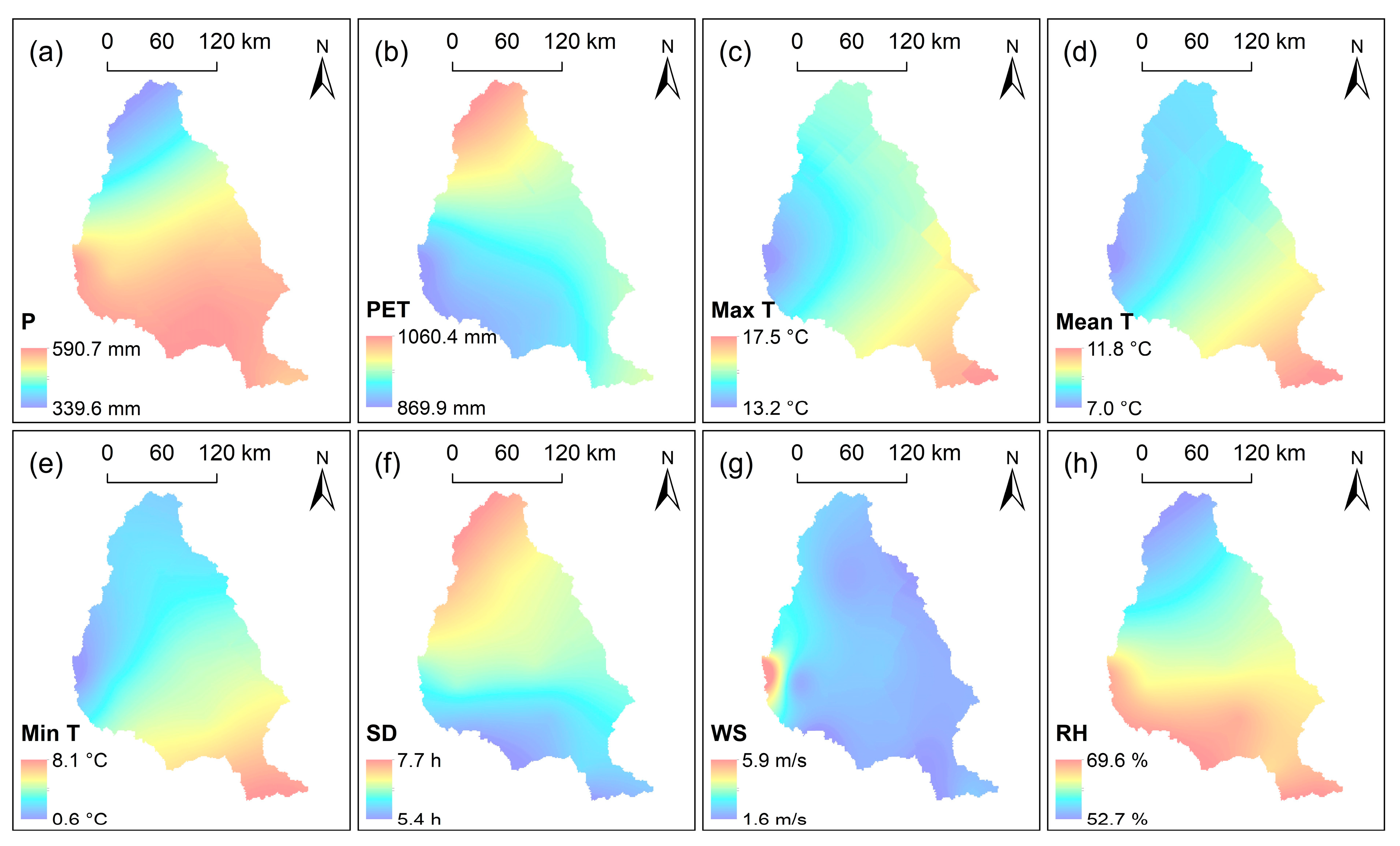
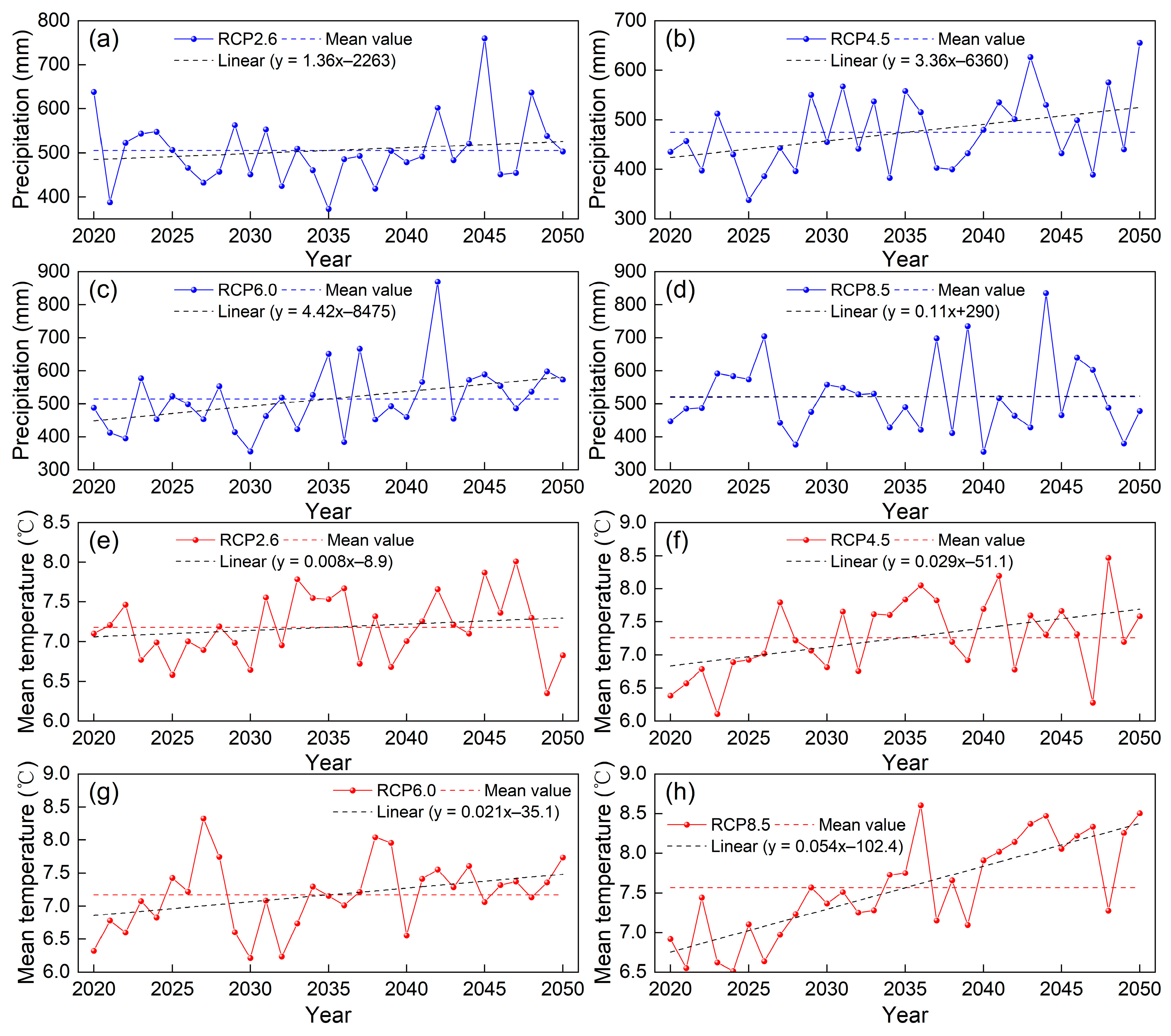


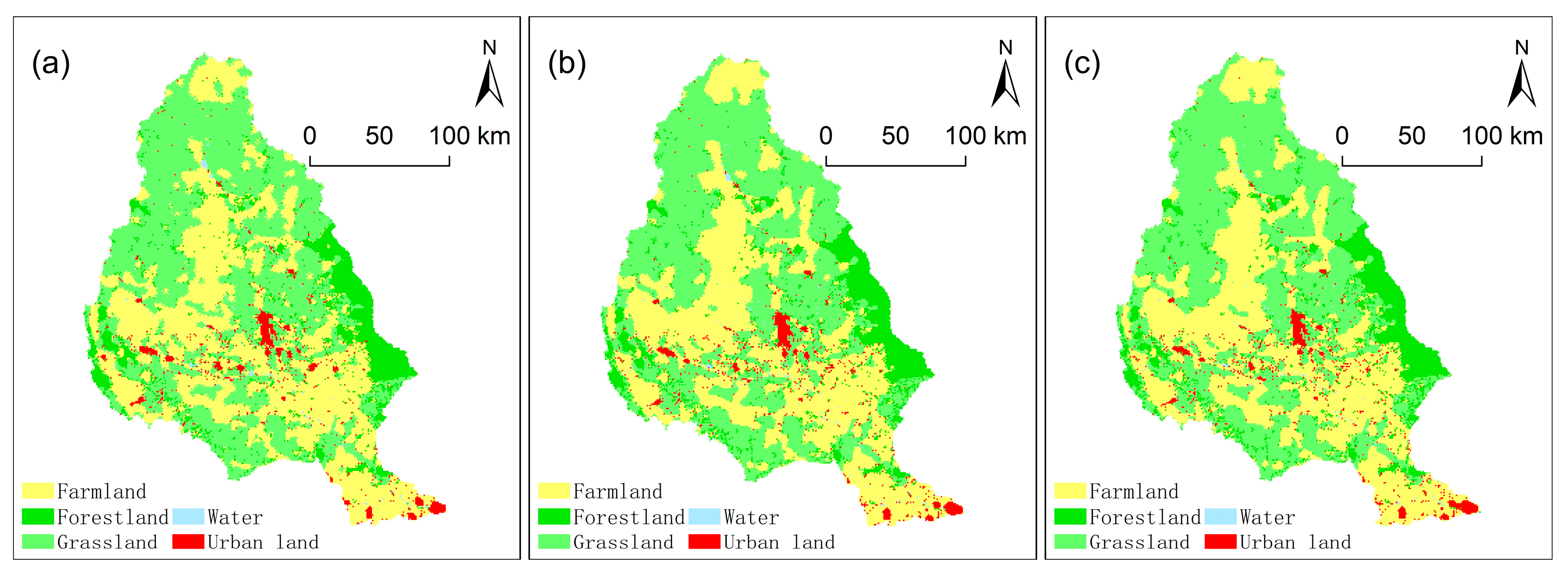


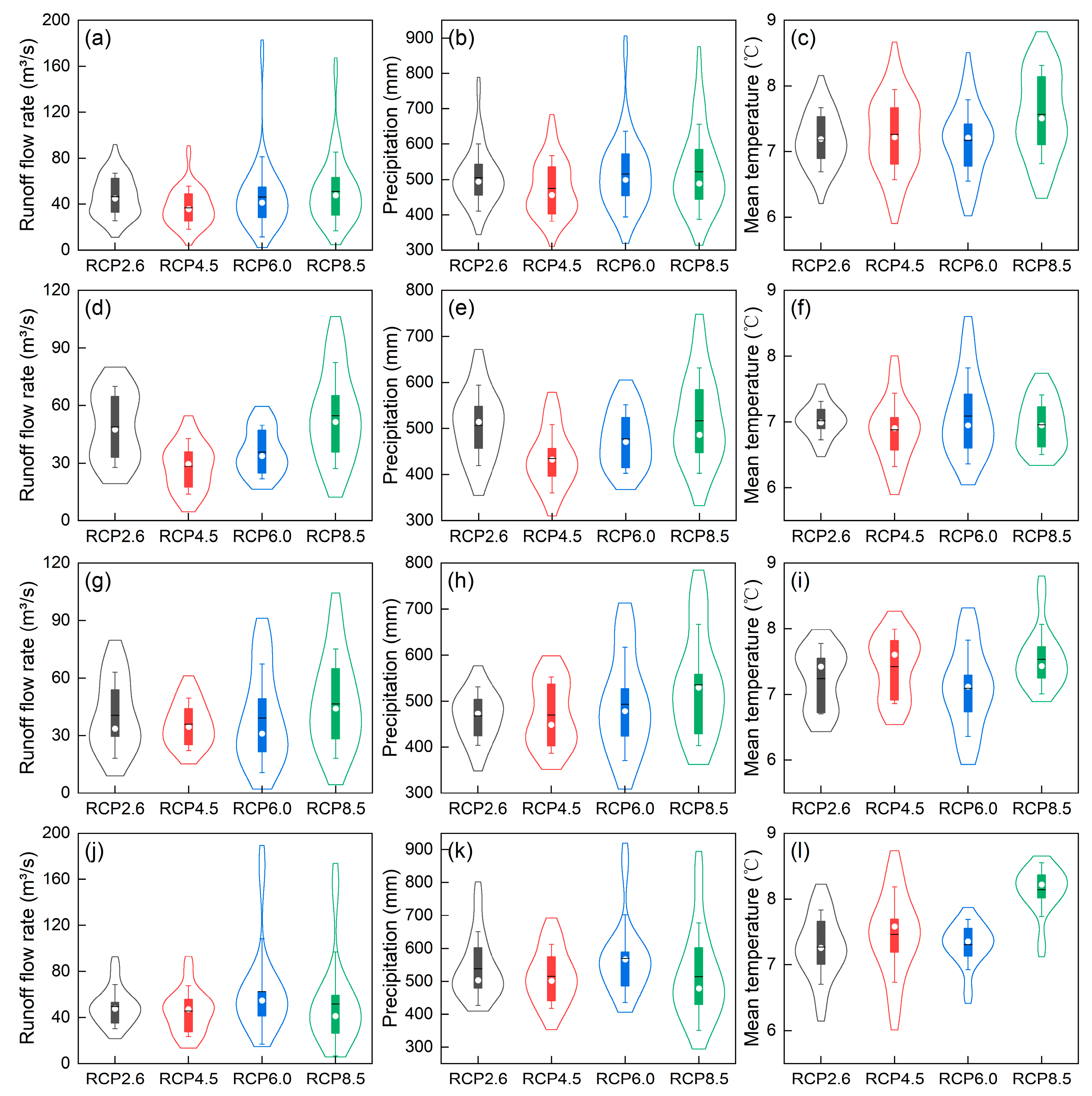
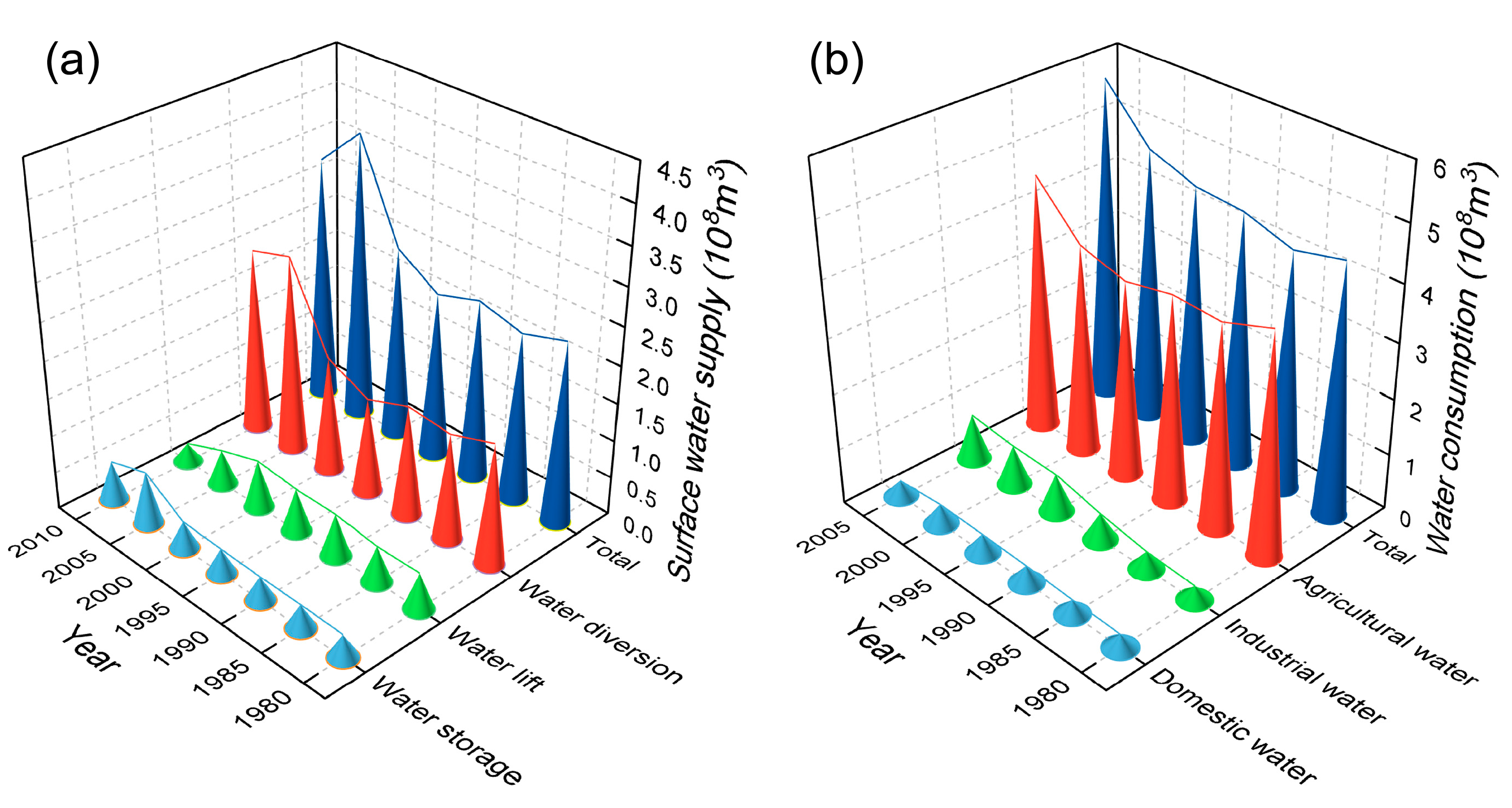
| Year | Area (km2) | Area Ratio (%) | ||||||||
|---|---|---|---|---|---|---|---|---|---|---|
| 1 | 2 | 3 | 4 | 5 | 1 | 2 | 3 | 4 | 5 | |
| 2018 | 18,224 | 4588 | 20,671 | 176 | 1184 | 40.64 | 10.23 | 46.10 | 0.39 | 2.64 |
| 2025 | 18,168 | 4728 | 20,475 | 176 | 1296 | 40.51 | 10.54 | 45.66 | 0.39 | 2.89 |
| 2035 | 18,054 | 4877 | 20,433 | 176 | 1303 | 40.26 | 10.88 | 45.57 | 0.39 | 2.91 |
| 2045 | 18,062 | 4885 | 20,428 | 149 | 1319 | 40.28 | 10.89 | 45.55 | 0.33 | 2.94 |
| Scene | P (mm) | R (m3/s) | ΔP (mm) | ΔR (m3/s) | ΔR/ΔP (m3/(mm·s)) |
|---|---|---|---|---|---|
| RCP2.6 | 505.2 | 45.80 | 30.8 | 9.58 | 0.31 |
| RCP6.0 | 515.2 | 45.77 | 40.8 | 9.55 | 0.23 |
| RCP8.5 | 521.9 | 50.36 | 47.5 | 14.14 | 0.30 |
| Climate Scenarios | Periods | R (m3/s) | P (mm) | Mean Temperature (°C) | |||
|---|---|---|---|---|---|---|---|
| K | Cv | K | Cv | K | Cv | ||
| RCP2.6 | 2020–2050 | 4.92 | 0.37 | 2.04 | 0.16 | 1.26 | 0.06 |
| 2020–2029 | 2.64 | 0.36 | 1.65 | 0.14 | 1.13 | 0.03 | |
| 2030–2039 | 4.10 | 0.46 | 1.49 | 0.11 | 1.17 | 0.06 | |
| 2040–2050 | 3.00 | 0.32 | 1.68 | 0.17 | 1.26 | 0.06 | |
| RCP4.5 | 2020–2050 | 8.53 | 0.43 | 1.94 | 0.16 | 1.39 | 0.08 |
| 2020–2029 | 4.93 | 0.43 | 1.63 | 0.14 | 1.28 | 0.07 | |
| 2030–2039 | 2.74 | 0.32 | 1.48 | 0.15 | 1.19 | 0.06 | |
| 2040–2050 | 3.94 | 0.40 | 1.68 | 0.16 | 1.35 | 0.08 | |
| RCP6.0 | 2020–2050 | 13.41 | 0.63 | 2.44 | 0.20 | 1.34 | 0.07 |
| 2020–2029 | 2.49 | 0.33 | 1.46 | 0.13 | 1.32 | 0.09 | |
| 2030–2039 | 6.26 | 0.61 | 1.87 | 0.21 | 1.29 | 0.09 | |
| 2040–2050 | 5.45 | 0.61 | 1.91 | 0.20 | 1.18 | 0.04 | |
| RCP8.5 | 2020–2050 | 10.34 | 0.56 | 2.35 | 0.22 | 1.32 | 0.08 |
| 2020–2029 | 4.22 | 0.42 | 1.87 | 0.18 | 1.16 | 0.05 | |
| 2030–2039 | 6.15 | 0.51 | 1.78 | 0.21 | 1.21 | 0.06 | |
| 2040–2050 | 6.94 | 0.73 | 2.35 | 0.26 | 1.17 | 0.04 | |
| Scene A1 | R (m3/s) | Climate Contribution Rate (%) | Scene A2 | R (m3/s) | LUCC Contribution Rate (%) |
|---|---|---|---|---|---|
| RCP2.6 | 45.80 | −8.06 | RCP2.6 | 46.38 | +1.27 |
| RCP4.5 | 36.22 | −27.30 | RCP4.5 | 36.81 | +1.64 |
| RCP6.0 | 45.77 | −8.12 | RCP6.0 | 46.29 | +1.14 |
| RCP8.5 | 50.36 | +1.10 | RCP8.5 | 51.04 | +1.35 |
Disclaimer/Publisher’s Note: The statements, opinions and data contained in all publications are solely those of the individual author(s) and contributor(s) and not of MDPI and/or the editor(s). MDPI and/or the editor(s) disclaim responsibility for any injury to people or property resulting from any ideas, methods, instructions or products referred to in the content. |
© 2023 by the authors. Licensee MDPI, Basel, Switzerland. This article is an open access article distributed under the terms and conditions of the Creative Commons Attribution (CC BY) license (https://creativecommons.org/licenses/by/4.0/).
Share and Cite
Liu, Y.; Guan, Z.; Huang, T.; Wang, C.; Guan, R.; Ma, X. Combined Effects of Land Use/Cover Change and Climate Change on Runoff in the Jinghe River Basin, China. Atmosphere 2023, 14, 1237. https://doi.org/10.3390/atmos14081237
Liu Y, Guan Z, Huang T, Wang C, Guan R, Ma X. Combined Effects of Land Use/Cover Change and Climate Change on Runoff in the Jinghe River Basin, China. Atmosphere. 2023; 14(8):1237. https://doi.org/10.3390/atmos14081237
Chicago/Turabian StyleLiu, Yu, Zilong Guan, Tingting Huang, Chenchao Wang, Ronghao Guan, and Xiaoyi Ma. 2023. "Combined Effects of Land Use/Cover Change and Climate Change on Runoff in the Jinghe River Basin, China" Atmosphere 14, no. 8: 1237. https://doi.org/10.3390/atmos14081237






